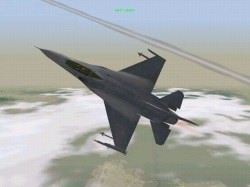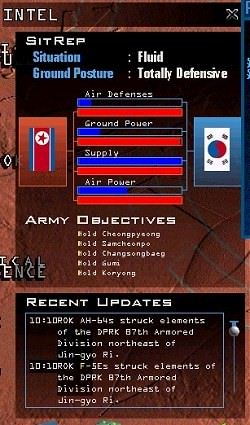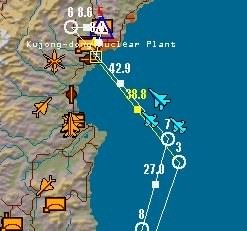| Falcon 4 Missile Avoidance: A Holistic Approach by Dave Pascoe |
||||
|
One of the very first things we learn in Falcon 4 is that missile avoidance is difficult, and often impossible, depending on your mission and what stage of the war you are in. This essay takes an holistic approach to missile avoidance, rather than the more usual topic of evading specific missile types.
The reasoning here is very simple: The F4 campaigns are bristling with missiles, so being able to dodge one or two is like bailing out the ocean with a tea cup. We can fool some of the missiles some of the time, but it won't be long before our luck runs out. We need to deal with the subject on a campaign-wide basis, which requires that the subject be placed into the context of the broader war effort. Many wonder whether F4 missile modeling is realistic. Reports from real world experience and literature suggest that it is (Note: Possible exception is the Archer. In F4 it seems impossibly fast). For the most part, our troubles with missiles stem from a lack of experience, training and reading materials. There are only two major wars that involved considerable fighter/missile experience -- Vietnam and Afghanistan. The circumstances of Desert Storm are of little value. They are too unique from the standpoint of the open desert, a not-so-smart enemy, and little having been written on the subject. From my readings, the record of both earlier wars indicate that missile technology, even as far back as the late 1960's, was extremely deadly. One has only to look at the record of the US Air Force and Navy to see just how deadly the NVA air defenses were. In Vietnam, fighter pilots fared poorly against strong missile defenses. US air losses in 'Nam were horrific, as were Russian losses in Afghanistan against the portable Stinger. It's hard to imagine shoulder-fired Stingers taking out MiG27's, but they did. CIA devised tactics were more than enough to make up for the limitations of the weapon. Strategy and setting up traps was the key to success. Do you want to know how bad US aircraft losses in Vietnam really were? The Pentagon itself is willing to admit to losses of 3,689 fixed wing aircraft and 4,857 helicopters, five times the number of Korea and about half of WWII (6,000). Moreover, two US fighters were lost for every three MiG's shot down in air battles. With those numbers, do you still think missiles aren't modeled accurately in F4? Those were pilots whose lives depended on their skill, and they still came up short. When it comes to air-to-air engagements, there is still very little in the way of real world experience after 'Nam. A2A combat was nonexistent in Afghanistan, and very limited in Desert Storm. In part, this is one of the reasons there is so much controversy regarding the whole spectrum of A2A missiles. No air force in the world (with maybe the sole exception of the IAF) really has much direct experience since there have been no major A2A wars since 'Nam. In point of fact, none of this should make much difference to the sim pilot. The only thing of importance is the missile modeling in the sim. THAT is what we have to learn. Whether it's accurate or not, that is the hand we are dealt and have to play. One of the most common complaints of Falcon drivers is hearing the audible warning "ARCHER INBOU . . . ." and blam! The warning isn't even finished before you are incinerated. In fact, I got so frustrated with this that I started timing it. On average, 3-5 seconds between warning and warhead explosion. About enough time to pump some flares and start a turn, but not enough time to avoid. Blam. Party's over! As Spectre pointed out in his recent article, there's really only one way to learn to deal with missiles . . . practice, practice, and more practice. Bear in mind that Falcon 4 is a new sim, just two months into its release, so most of us have a long way to go before we gain a strong body of knowledge. And as most of us discover, what works in one sim, don't necessarily work in another. In the meantime, here are a few more tips based on my meagre 168 hours of cockpit time. I don't profess to be an accomplished pilot, but hopefully what I have learned can help other novices -- especially those of you who, like myself, got a lot more than they bargained for with Falcon 4. Make no mistake, this is one tough sim. When considering missile avoidance tactics, the subject must be kept in context of the kind of mission we are flying and weapons we're carrying. Balancing the risks of achieving one's goals versus staying alive is a constant consideration. It must also be considered where you stand in regard to air superiority and the overall war. That means that early on, when both the ground and skies are thick with missiles, just staying alive becomes the number one job. We are not going to be able to just select missions that suit our fancy and go merrily on our way blasting hell out of the enemy. War does not work that way. There is a natural order of battle and we must get in tune with it sooner or later. Moreover, if the frag order in our campaign hasn't got things right, we've got yet another problem. You ain't gonna fly BAI's into an area thick with defenses and succeed. While mission planning is not the major subject of this essay, please note that it is an underlying theme that everything you do must be considered in the overall context of the war. There is no escape from this reality, even in a simulation. If you are a TAW or F-15 flier, you know you have exactly the same problem in those sims. Missions must be flown in their proper order or failure will be the only result. If, like me, you are not a graduate of the War College, then you'll also quickly discover that you have a long way to go before you gain a basic grasp of war strategy. It takes time to learn what missions to fly at what point in the war. This is something to always keep in the back of your mind. Ultimately, we are just students, not experts. We have a lot to learn. In the meantime, we get shot down a lot. 1. Avoidance The most effective key to both types of missile avoidance is to stay out of harm's way. In working campaigns, I've discovered that there are an abundance of no-win situations in the frag orders; these are conditions in which the enemy air and ground defenses are so strong that I am not going to survive if I fly head-on into them. That includes combinations of air and ground elements. Consider this statement taken from World Air Power Journal: "There is no place for sportsmanship or chivalry in air combat - the aim is to do maximum damage while exposing oneself to minimum risk." |
 While I've found most of the information in the F4 manual to be accurate, I did find this amazing statement: " . . . most of the time your route should keep you away from SAMS and AAA." [p.27-15]. If you take that to mean that the default mission flight plan will keep you out of harm's way, think again. I've found that well over half the time, at least in early stages before many SEAD missions have been flown, the default flight plan will fly you straight into a veritable hornet's nest of opposition. In fact, there are so many air defenses, they are hard to avoid. Instead, take that to mean, "YOU should keep your route away from SAMS and AAA." Don't expect the mission planners to do this for you. They don't. If your experience is anything like mine, you've found the theater map difficult to use for intel gathering and mission planning. What we see, at least superficially, on the map looks relatively benign, yet when we get where we're going, its an entirely different matter. You find SAM and AAA batteries all over the place that didn't show on the map. (That's because many of the mobile air defenses are listed with the infantry or army air defense units, and don't show up as symbols. You have to call up each battalion and expand the inventory to see what they have. That takes a lot of time.) As a result, you find yourself blasted out of the sky time and time again. This gets very frustrating. Nor should we forget that the manageable few CAP flights that do appear can be quickly augmented by reinforcements. The enemy does scramble missions too.
 2. Gathering Threat INTEL As any real world pilot knows -- not to mention quite a few dead ones -- it is suicide to fly a mission without a reasonable degree of certainty what threats you're going to encounter. The key to survival is in keeping the odds in your favor, whether by threat avoidance or management. Pilots are inveterate map readers and intel gatherers, and we should be too. If we don't think we're getting adequate intel from the sim, then the only solution is to assemble our own. Remember, you wanted a realistic sim, so if you expect to beat the AI, then you'll have to resort to real world tactics and do what real fighter pilots do. Yes, it is time-consuming, but less so than seaching through all those unit inventories. Making my own maps was the first thing I did that improved my mission success. I photocopy-enlarged the map provided, then started drawing in the flight plans I had flown, then marking the air defenses with colored pens as I located them. That means stopping the mission and filling in the map. How to Print F4 Maps:
 The worst of these defenses are usually found just past the forward line of battle or FLOT, followed by the fixed installations around NK bases deeper in enemy territory. By the time you do this on a half-dozen missions, you'll get a pretty good picture of what you're up against, one that you can't get from the theater map. In the end, you'll find this takes quite a bit less time than all that clicking around you have to do on the theater map. Go to Part II
|
|||
|
© 1997 - 2000 COMBATSIM.COM, INC. All Rights Reserved. Last Updated February 22nd, 1999 |
||||
